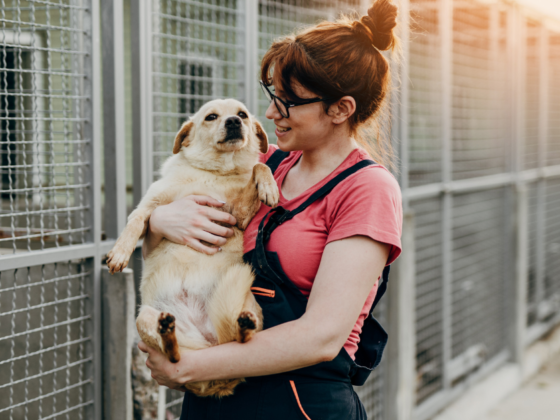Are you looking to help an animal in need? If so, first of all, thank you on behalf of all animal lovers. While we would all love to house as many animals as our houses and apartments can hold, oftentimes it just becomes too much
And yet, the will to volunteer at an animal shelter might just be the right opportunity to aid countless animals in need. If you’re looking to volunteer, we have the low-down on how to get started and what is required. Perhaps this is the sign you need to make a difference. But, in the off chance that you love cuddling up to a sweet dog or cat, then maybe that’s reason enough to become a volunteer. Either way, there’s always a need for volunteers from all walks of life.
How To Volunteer At An Animal Shelter
Before jumping into volunteer life, you should make the first step by researching local shelters in your area. You’ll want to look for a shelter that is relatively close to home, to avoid long commutes or time spent away from your own pets. Check out our own CUDDLY Shelter and Rescue Search to see what local shelters and rescues are near you. Once you find one close by, either check out their website or call to see if they are looking for volunteers.
What Does An Animal Shelter Volunteer Do?
What doesn’t an animal shelter volunteer do! Think about the care that is required for your own pet. There’s the fun side like walks, playtime, and even training/socialization if you’re inclined. However, the other side to volunteering involves much more than the basic care of animals.
If you’re someone who likes to provide support in other ways, that could be an option as well. Many shelters have to do their own in-house promotion, fundraising, bookkeeping, and even legal services, so you could serve to aid with:
- Event Planning & Fundraising
- Day-to-Day Operations (ex: phone calls, accounting, bookkeeping, contracts)
- Design (ex: website design, photography, newsletters)
- Social Media
If you’re looking to interact with the animals and care for them one-on-one many of the roles are all-encompassing and may include:
- Playing with and exercising the animals (ex: long walks, fetch, etc.)
- Cleaning up after the animals (this may not be anyone’s favorite role, but it is essential to maintaining a clean and healthy environment for the animals)
- Feeding and helping the veterinarian with medical requirements (ex: giving medicine, treating wounds, dispensing food)
- Behavioral and training work (ex: socialization with other animals and humans)
As this list suggests, animal volunteers do a lot. They are caretakers, administrators, cleaners, creatives, and fundraisers; every role plays a part in the overall goal to get animals adopted. However, before adoption can begin, many animals need to be cared for or even nursed back to health.
Animal Shelter Volunteer Requirements
Shelter requirements differ depending on the facility. Most have an intake form of some variety and require some basic understanding of caring for animals. However, if you still want to help in a more back-end role, that could also be an option. Not every volunteer has to care for animals directly to make an impact. The roles vary and every volunteer is suited differently. However, the commonality is dedication to helping animals in need. Below are typical requirements asked of volunteers.
Time Commitment – Some shelters require a certain amount of hours per month. While others require a certain amount of months. This often helps shelters as they schedule roles, but also helps volunteers develop relationships with the animals.
Physical Requirements – You may be asked to lift heavy objects, operate machinery, or work outside, so that is something to consider before volunteering.
Experience with Animals – If you are seeking a volunteer role that involves interacting with animals, you should be capable of tolerating some jumping, rambunctious play, and even loud noises (one bark can set off many more)
You shouldn’t worry if you don’t fit all of these suggested abilities. There are plenty of other opportunities to volunteer and make a difference. You could even be a part of

dealing with potential adopters before they bring their future pet home. Your support could ease any worries an adopter could potentially have. There’s always a role no matter the background.
How Old Do You Have To Be To Volunteer At An Animal Shelter?
18+ is the typical age for volunteering. But don’t let this deter you from reaching out to different shelters if you’re younger. Some shelters want to incorporate teens and even children into volunteer programs. In fact, St. Hubert’s Animal Welfare Center, allows those 16 and older to volunteer in non-animal handling roles.
Many shelters are looking to involve younger volunteers so that they understand the value of caring for an animal. If you have a child looking to get involved, consider contacting your local animal shelter to see if they have any programs in place for younger volunteers.
Animal Shelter Volunteer Positions
Shelter volunteer positions differ depending on location and the animals they are caring for. Your local animal shelter can better explain how they structure their facility.
However, in one example of how a shelter runs, OC Animal Care, a shelter located in Tustin, California, provides training to all volunteers before starting. Their positions include:
- Dog Walker – Socialize and exercise dogs available for adoption
- Cat Socializer – Work with cats on mental stimulation and practice being handled
- Rabbit Socializer – Some rabbits are not used to being handled, so volunteers help them work on social skills
- Greeter/Customer Service – These volunteers greet and assist customers with their adoption journey
- Community Events/Special Shelter Events – Volunteers work to promote adoption and special events
- Clerical Support – Assist with office duties and improve efficiency of work
- Groomer – Bond with dogs and help them learn trust – while getting clean
- Kitten Nursery Attendant – Feed, clean, and care for small kittens in the nursery
Do Animal Shelter Volunteers Get Paid?
Some shelters do have a paid staff, but depending on the funding others are strictly volunteer positions. Britney Wallesch of Black Dog Animal Rescue (BDAR) founded a rescue based off of volunteer support, but after a few years some core volunteers were devoting 40-60 hours a week to keep up. This is a major undertaking for anyone, especially if it is unpaid.
BDAR was able to gain support from donors and the local community to be able to pay for a few staff to run the rescue full-time. Britney’s decision to change the structure of her rescue actually had an incredibly positive impact on the programs they were then able to run.
This is just one example of how a rescue can still operate with a few paid staff devoting their full-time and energy to help things run smoothly and possibly raise even more money.
If you are interested in volunteering or in a potential paid position, you should contact your local shelter for more information.
What Animal Shelters Need Volunteers?
Volunteers are usually always in need for shelters around the country. However, if you’re looking for a specific search option in your state, the Humane Society of the United States has a search option available for volunteers. There you can search for volunteer opportunities by location and by program type. They even have some national positions that are available from home or in more rural areas.
The Humane Society has also created a program called the Rural Area Veterinary Services (RAVS) to expand access to veterinary care in rural communities that face poverty and geographic isolation. Through this program, their teams have treated more than 135,000 animals at no cost to the owner or community. At 350 volunteers throughout the U.S. they are still looking for more to join. You can check out their volunteer requirements page and volunteer checklist before submitting an application.
Volunteering At An Animal Shelter Matters
There will always be a need for volunteers even as we all strive to wplace every animal in a safe and loving home. But the time before adoption is so important to help an animal learn socialization and to trust humans. Not only do volunteers care for the basic necessities, they can also aid veterinarians in bringing animals back to their best health.
None of these tasks are easy, but they are worth it. Helping to change an animal’s life is an extremely important and rewarding experience. Some may even find that they enjoy donating money, time, and love to this endeavor over other activities. Volunteering is truly a wonderful way to spend time and love some amazing animals. Giving back to animals in need could even be the thing that makes you feel best of all.










